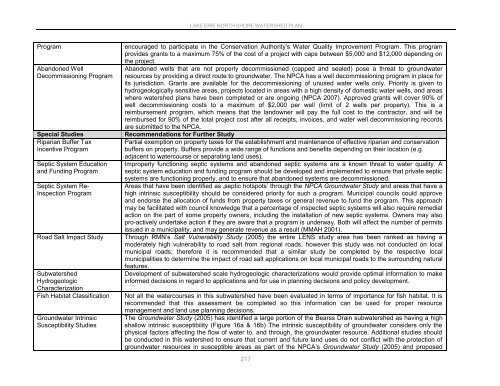Lake Erie North Shore Watershed Plan - Niagara Peninsula ...
Lake Erie North Shore Watershed Plan - Niagara Peninsula ...
Lake Erie North Shore Watershed Plan - Niagara Peninsula ...
Create successful ePaper yourself
Turn your PDF publications into a flip-book with our unique Google optimized e-Paper software.
LAKE ERIE NORTH SHORE WATERSHED PLAN<br />
Program<br />
Abandoned Well<br />
Decommissioning Program<br />
Special Studies<br />
Riparian Buffer Tax<br />
Incentive Program<br />
Septic System Education<br />
and Funding Program<br />
Septic System Re-<br />
Inspection Program<br />
Road Salt Impact Study<br />
Subwatershed<br />
Hydrogeologic<br />
Characterization<br />
Fish Habitat Classification<br />
Groundwater Intrinsic<br />
Susceptibility Studies<br />
encouraged to participate in the Conservation Authority‟s Water Quality Improvement Program. This program<br />
provides grants to a maximum 75% of the cost of a project with caps between $5,000 and $12,000 depending on<br />
the project.<br />
Abandoned wells that are not properly decommissioned (capped and sealed) pose a threat to groundwater<br />
resources by providing a direct route to groundwater. The NPCA has a well decommissioning program in place for<br />
its jurisdiction. Grants are available for the decommissioning of unused water wells only. Priority is given to<br />
hydrogeologically sensitive areas, projects located in areas with a high density of domestic water wells, and areas<br />
where watershed plans have been completed or are ongoing (NPCA 2007). Approved grants will cover 90% of<br />
well decommissioning costs to a maximum of $2,000 per well (limit of 2 wells per property). This is a<br />
reimbursement program, which means that the landowner will pay the full cost to the contractor, and will be<br />
reimbursed for 90% of the total project cost after all receipts, invoices, and water well decommissioning records<br />
are submitted to the NPCA.<br />
Recommendations for Further Study<br />
Partial exemption on property taxes for the establishment and maintenance of effective riparian and conservation<br />
buffers on property. Buffers provide a wide range of functions and benefits depending on their location (e.g.<br />
adjacent to watercourse or separating land uses).<br />
Improperly functioning septic systems and abandoned septic systems are a known threat to water quality. A<br />
septic system education and funding program should be developed and implemented to ensure that private septic<br />
systems are functioning properly, and to ensure that abandoned systems are decommissioned.<br />
Areas that have been identified as „septic hotspots‟ through the NPCA Groundwater Study and areas that have a<br />
high intrinsic susceptibility should be considered priority for such a program. Municipal councils could approve<br />
and endorse the allocation of funds from property taxes or general revenue to fund the program. This approach<br />
may be facilitated with council knowledge that a percentage of inspected septic systems will also require remedial<br />
action on the part of some property owners, including the installation of new septic systems. Owners may also<br />
pro-actively undertake action if they are aware that a program is underway. Both will affect the number of permits<br />
issued in a municipality, and may generate revenue as a result (MMAH 2001).<br />
Through RMN‟s Salt Vulnerability Study (2005) the entire LENS study area has been ranked as having a<br />
moderately high vulnerability to road salt from regional roads, however this study was not conducted on local<br />
municipal roads; therefore it is recommended that a similar study be completed by the respective local<br />
municipalities to determine the impact of road salt applications on local municipal roads to the surrounding natural<br />
features.<br />
Development of subwatershed scale hydrogeologic characterizations would provide optimal information to make<br />
informed decisions in regard to applications and for use in planning decisions and policy development.<br />
Not all the watercourses in this subwatershed have been evaluated in terms of importance for fish habitat. It is<br />
recommended that this assessment be completed so this information can be used for proper resource<br />
management and land use planning decisions.<br />
The Groundwater Study (2005) has identified a large portion of the Bearss Drain subwatershed as having a high<br />
shallow intrinsic susceptibility (Figure 16a & 16b) The intrinsic susceptibility of groundwater considers only the<br />
physical factors affecting the flow of water to, and through, the groundwater resource. Additional studies should<br />
be conducted in this watershed to ensure that current and future land uses do not conflict with the protection of<br />
groundwater resources in susceptible areas as part of the NPCA‟s Groundwater Study (2005) and proposed<br />
217
















